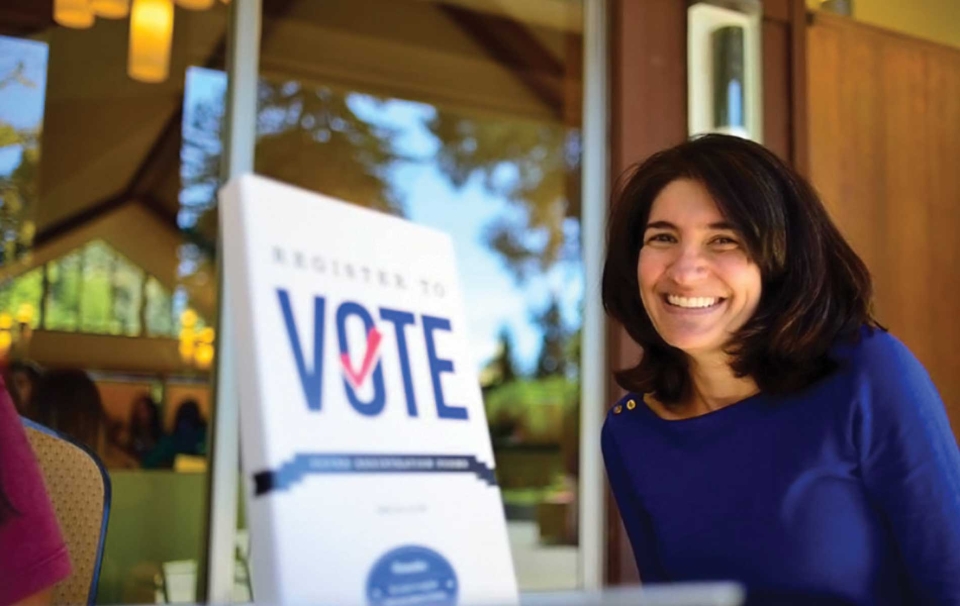Breadcrumbs
- News
- News Archive
- State Of The Union

When President Trump delivered his rescheduled State of the Union Address on February 5, Dominican University of California political scientist Alison Howard was watching to see how he used the Address to both communicate with the public and make specific requests of Congress.
Howard recently talked with the Boston Globe, San Francisco's KTVU, and Deseret News about the history of the speech. On January 23, President Trump said he would deliver his Address when the government shutdown was over.
Delays, Howard says, have happened in the past. In 1986, for example, President Reagan postponed his State of the Union Address by a week because of the Challenger disaster.
“There isn't anything in the Constitution about the State of the Union having to be on a specific day or at a specific time,” Howard said. “Postponing the Address until the government re-opens allows both the president and the Congress to focus on the issues at hand and provides an opportunity for the president to deliver the State of the Union Address in the House Chamber to set his legislative agenda, claim credit for accomplishments, and frame recent events in a manner that he chooses.”
When asked on January 16 to weigh in Speaker Nancy Pelosi's request that President Trump either postpone the speech or deliver it in writing, Howard told the Boston Globe that it is rare — but not unheard of — for a modern president to not deliver the State of the Union in person. Presidents Wilson, Hoover, Carter, and Nixon have presented a written version.
Howard and colleague Donna Hoffman, professor in the Department of Political Science at the University of Northern Iowa, have spent more than a decade studying presidential State of the Union addresses. In their book, Addressing the State of the Union, Howard, chair and assistant professor of Political Science and International Studies, and Hoffman examine the evolution of the annual State of the Union Address and outline the ways presidents use the address to gain attention, to communicate with target audiences, and to make specific policy proposals.
Hoffman and Howard examine the addresses to better understand how successful or unsuccessful presidents are in accomplishing their legislative requests. They calculate how many of the legislative requests presidents make of Congress in their State of the Union Address get adopted during the year following the Address.
View Alison Howard's research in Dominican's Experts Directory.
Over the years, presidents have used the State of the Union address as a means of winning public support for their policies. Modern presidents (presidents since 1965) include specific calls for Congressional action in their State of the Union address, with a median of 31 requests per address, ranging from President Carter’s 1979 low of nine to President Clinton’s high of 87 requests in 2000.
Ronald Reagan began the process of incorporating key individuals into his State of the Union address in 1982 as representations of what he called American heroes, Howard says. George Bush continued Reagan’s practice of recognizing key people, and Bill Clinton used guests as symbols of the policy successes for which he claimed credit. He also introduced AmeriCorps participants as a way of touting the program as a success while making the case that Congress should not cut the program.
Howard notes that Barack Obama’s rhetorical choices in the State of the Union address portrayed him as an unusual chief legislator in many ways. He was deferential to Congress on legislative detail, tending to focus his State of the Union address requests on large-scale items and leaving the details of legislation to Congress. His use of symbolic rhetoric also was unique.
“President Obama used individuals and historical examples to highlight the instrumental and effective role government has played in supporting the pursuit of the American dream,” Howard says. “He offered recognizable examples that match his vision of the role of government in order to persuade Congress and the public that his agenda is one that should be enacted.”
Obama’s median full and partial request success rate was about 45 percent during his first term -- practically identical to Reagan’s full terms in office and slightly above the median yearly rate of 43 percent. However, Obama’s success rate declined when the Republicans took control of the House in 2011. In 2012, his full and partial success rate was 21.4%. In 2013, only two of his legislative requests were enacted by Congress for a success rate of 4.9%. In 2014, he fared slightly better, with 13.8% of requests fully successful and 17.2% of requests either fully or partially successful. In 2015, 28.6% of Obama’s requests were fully successful and 35.7% were either fully or partially successful.
Howard and Hoffman continued their research as President Trump made his State of the Union address.
“While nothing about the Trump presidency has been traditional or conventional, the State of the Union address is an occasion where we would expect to see some similarities with other presidents,” Howard says. “The address is an opportunity for presidents to articulate a legislative agenda, claim credit for accomplishments, and propose solutions to policy problems.”